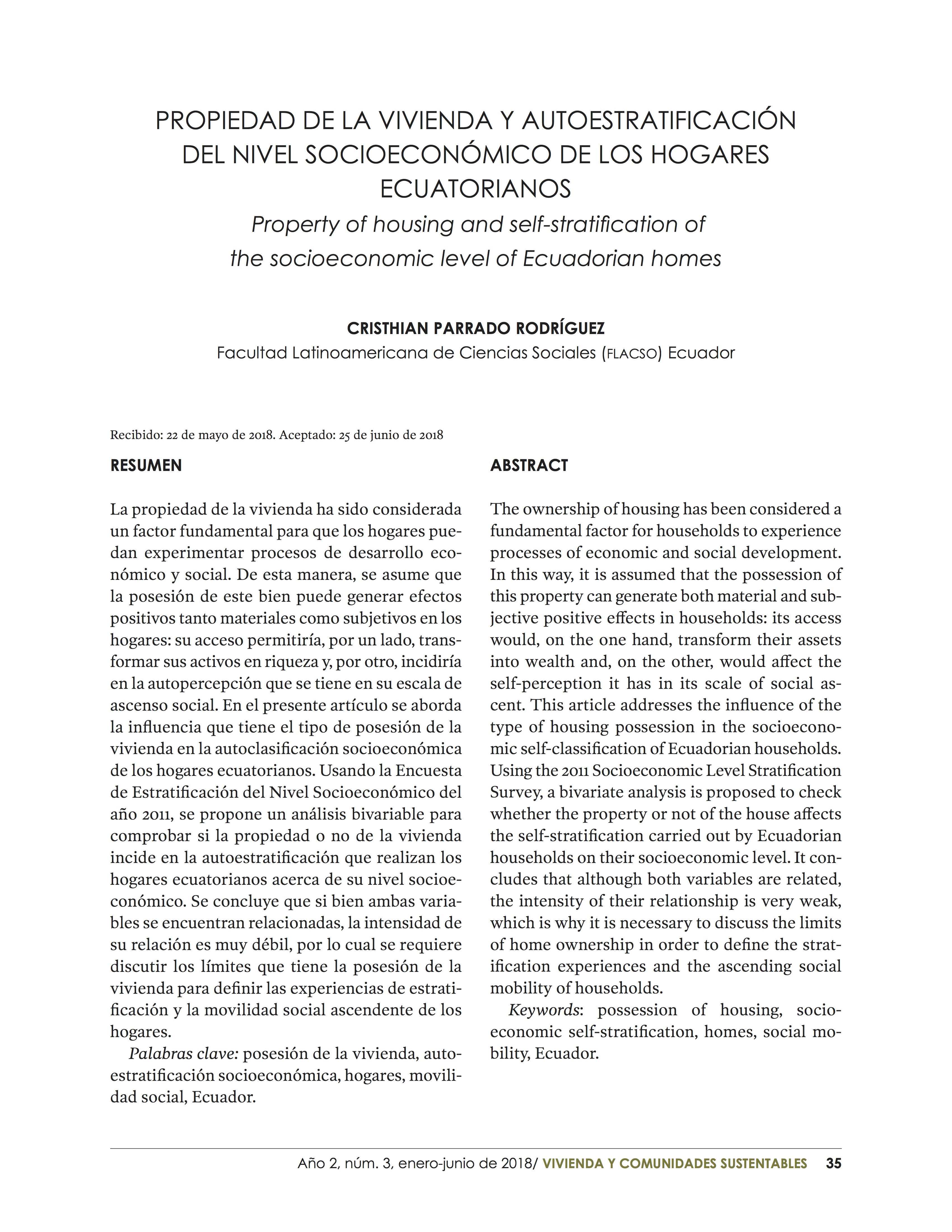Property of housing and self-stratification of the socioeconomic level of Ecuadorian homes
DOI:
https://doi.org/10.32870/rvcs.v0i3.79Keywords:
possession oh housing, socioeconomic self-stratification, homes, social mobility, EcuadorAbstract
The ownership of housing has been considered a fundamental factor for households to experience processes of economic and social development. In this way, it is assumed that the possession of this property can generate both material and subjective positive effects in households: its access would, on the one hand, transform their assets into wealth and, on the other, would affect the self-perception it has in its scale of social ascent. This article addresses the influence of the type of housing possession in the socioeconomic self-classification of Ecuadorian households. Using the 2011 Socioeconomic Level Stratification Survey, a bivariate analysis is proposed to check whether the property or not of the house affects the self-stratification carried out by Ecuadorian households on their socioeconomic level. It concludes that although both variables are related, the intensity of their relationship is very weak, which is why it is necessary to discuss the limits of home ownership in order to define the stratification experiences and the ascending social mobility of households.Metrics
References
Bourdieu, P. (2002). Condición de clase y posición
de clase. Revista Colombiana de Sociología, VII(1): 119-141.
De Soto, H. (2000). El misterio del capital: Por qué el capitalismo triunfa en Occidente y fracasa en
el resto del mundo. Lima: El Comercio.
Fernandes, E. (2012). Una lectura crítica de Hernando de Soto. En: Salazar, C. (Ed.), Irregular. Suelo
y mercado en América Latina (pp. 212-239). México, DF: El Colegio de México.
Fierro, J. (2010). Análisis estadístico univariado, bivariado y variables de control. Recuperado el
de abril de 2018 de: http://chitita.uta.cl/cursos/2012-1/0000104/recursos/r-25.pdf
Hernández, R., Fernández C., y Baptista, P. (2010). Concepción o elección del diseño de investigación.
En: Hernández, R., Fernández, C., y Baptista, C. (Eds.), Metodología de la investigación (pp. 118-170). México, df: McGraw-Hill.
Instituto Nacional de Estadísticas y Censos. (2011). Encuesta de estratificación del nivel socioeconómico. Recuperado el 17 de abril de 2018: http://www.ecuadorencifras.gob.ec/encuesta-de-estratificacion-del-nivel-socioeconomico/
Jaramillo, S. (2009). Hacia una teoría de la renta del suelo urbano. Bogotá: Universidad de los Andes.
King, G., Keohane, R., y Verba, S. (2005). El diseño de la investigación social. Madrid: Alianza.
Maldonado, M. M. (2004). Propiedad y territorio en la Constitución de 1991. En: Arocha, J. (Ed.), Utopía para los excluidos. El multiculturalismo en África y América Latina (pp. 347-364). Bogotá: Universidad Nacional de Colombia-Facultad de Ciencias Humanas.
Palomar, J., y Lanzagorta, N. (2005). Pobreza, recursos piscológicos y movilidad social. Revista Latinoamericana de Psicología, 37(1): 9-45.
Pineda, J., Scandinazzo, S., y Freije, S. (2007). Activos para la movilidad social: Crédito, tierra y vivienda. En: Corporación Andina de Fomento (eds.), Oportunidades en América Latina. Hacia una mejor política social (pp. 191-226). Caracas: Corporación Andina de Fomento.
Rocha, S. Y. (2007). Pobreza, socialización y movilidad social. Tesis de Doctorado en Investigación Psicológica. México, df: Universidad Iberoamericana.
Sánchez, J. J. (1995). Tablas de contingencia: Relación entre variables nominales (ordinales). En: Sánchez, J. J. (Ed.), Manual de análisis de datos (pp. 249-302). Madrid: Alianza Editorial.
Vicéns, J., y Medina, E. (2005). Análisis de datos cualitativos. Recuperado el 17 de abril de 2018 de: https://www.uam.es/personal_pdi/economicas/eva/pdf/tab_conting.pdf

Downloads
Published
How to Cite
Issue
Section
License
Copyright (c) 2018 Vivienda y Comunidades Sustentables

This work is licensed under a Creative Commons Attribution-NonCommercial-NoDerivatives 4.0 International License.
The authors who publish in this journal accept the following conditions:
In accordance with the copyright legislation, Sustainable Housing and Communities recognizes and respects the moral right of the authors, as well as the ownership of the patrimonial right, which will be transferred to the University of Guadalajara for its dissemination in open access. Sustainable Housing and Communities does not charge authors for submitting and processing articles for publication. Authors may make other independent and additional contractual agreements for the non-exclusive distribution of the version of the article published in Sustainable Housing and Communities (for example, include it in an institutional repository or publish it in a book) as long as they clearly indicate that the work is published for the first time in Sustainable Housing and Communities.





